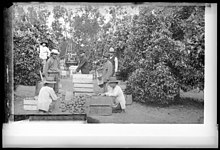
The Citrus Strike of 1936 was a strike in southern California among citrus workers for better working conditions that took place within various cities within Orange County, such as Fullerton and Anaheim from June 10 to July 25. There were multiple factors that led the citrus workers to strike including their paid wages, working conditions, living conditions, and overall social dynamics. The strike itself was significant for ending the myth of "contented Mexican labor."[1] It was one of the most violently suppressed strikes of the early 20th century in the United States. The sheriff who suppressed the largely Mexican 3,000 citrus pickers was himself a citrus rancher who issued a "shoot to kill" order on the strikers. The aftermath of the strike effort led to 400 citrus workers being arrested in total, while others were forced to either face jail time or possible deportation back to Mexico.[1][2][3] It has also been referred to as the Citrus War[4] and the Citrus Riots.[5]
- ^ a b "UCI Libraries - Immigrant Lives in the OC and Beyond: Work". www.lib.uci.edu. Retrieved 2022-12-05.
- ^ "The Citrus War of 1936 Changed Orange County Forever and Cemented Our Mistrust of Mexicans – OC Weekly". www.ocweekly.com. Retrieved 2022-12-05.
- ^ Tour, Jesse La (2019-12-17). "The Roots of Inequality: The Citrus Industry Prospered on the Back of Segregated Immigrant Labor -". fullertonobserver.com. Retrieved 2022-12-05.
- ^ "Orange County's lost essence". Los Angeles Times. 2008-08-10. Retrieved 2022-12-05.
- ^ "Blood Orange: The 1936 Citrus Strike in Orange County". UFCW 324. 2008-07-01. Retrieved 2022-12-05.
